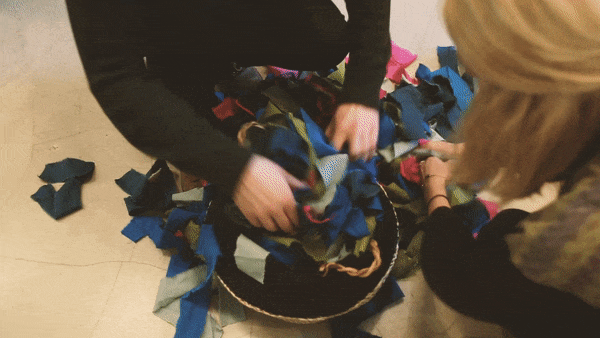Woven Identity
Inclusive + Decolonizing Exploration
Information
Umea Institute of Design
Duration: 5 weeks
Type: Ethnographic Research + Service, Participatory Design
Team: Maja Bjorkqvist, Ivan Kunjasic, Selvi Olgac, Geert Roumen, Shib Sahoo Shankar
Partners
“What Happens When Different Communities Look Into Each Other’s Curious Eyes?”
Context
As designers in this globalized world, we must be highly conscious of the impact that our work has on cultures around us.
The goal of this project was to be self-critical in our methodologies and thought processes. Here, we attempt to analyze colonizing practices of our own design through collaboration with the indigenous people of Sweden, the Sámi.
Approach
We deconstructed our own preconceived definitions of design, reflecting on our position and responsibilities as designers.
This self-reflection was facilitated through collaboration with those who have different world views. We worked with the indigenous population in Sweden, the Sámi, and our own classmates, using the age-old method of story telling as a communication tool and foundation of our co-creation project.
Creation
Exploring the interconnection between diverse cultures, the experiential crossroads where two communities meet.
We shifted perspectives and saw "otherness" as "togetherness," bringing to life the knowledge we gained from our experiences. We created a final interactive exhibition at the "Priority Minority" gallery in Vasterbotten Museum in Umea.
Experiential Research + Story Collecting
Decolonizing Workshop + Reflections
Co Creation Prototyping + Final Museum Exhibit
How do we decolonize design?
...Let's start with some questions...
and Discuss the foundation of inclusive design….
Experiential Research

Who are the Sami?
The indigenous people of Scandinavia
They settled in the northern parts of Norway, Sweden, Finland, and Russia over 12,000 years ago, as a nomadic hunting, reindeer herding, and gathering people with a deep sense of culture. Today, there around 80-100,000 Sami living throughout this territory, speaking their own language.
In the face of adversity and discrimination
Historically, the Sami have faced great discrimination throughout the 18th and 19th century. The Scandinavian governments treated them as a lesser race, dismantling their cultural practices and placing Sami children in missionary boarding schools. The Sami were effectively segregated from society, and pushed off their land. Today they still face discrimination, and pressures from factors such as climate change, and mining and logging companies.
Working hard To keep their ancient culture alive and community strong
Today, there is little education about the adversity they faced, but their culture has been slowly rebuilt through story telling and the renaissance of traditional practices. The Sami today pass down their culture through handicrafts, joiking, (a form of singing),the mythology of the their ancient religion, and story telling.
Indigenous Research Methodologies
We traveled to Ovre Soppero to learn first hand from a Sami community about their culture. We came with an open mind, eager to engage in an experiential way and push aside our preconceived world views.
Listen
Keep an open mind, and acknowledge the different perspective that shape others' world views and culture.
Experience
Absorb the surroundings, systems, and relationships through experiential moments, rather than formal interactions that set you apart.
Learn
Learn holistically, taking care to be humble and respectful. Understand the incredible knowledge and insight that the community bestows upon you.
Participate
Engage with individuals, and the larger community. Learn through this participation, and give back positive energy and appreciation.
Participatory Storytelling Workshop
After our experiential research, we wrote stories of personal importance, gathered from the trip...
Stories were loosely categorized under umbrellas, and linked together to with rope show the interconnections and relations. We then reflected on the stories we chose to tell, the way we told them, and others' interpretations of our experiences as portrayed through written language.
Post Workshop Organization + Synthesis:
After synthesizing our experiences and stories, we gathered as a class and brainstormed how to take our material and shape it into something that we could translate into a reflective and interactive museum exhibit. Following this, we formed groups natural to our experience, and continued to the ideation phase.
What gives you Identity?
Our group focused on how we form identity both as individuals and as a collective community. As seen through our experience with the Sami, they are highly interconnected with the natural systems around them as well as their ancient heritage and livelihoods. These in turn shape their worldview, and collective cultural values.
Through observing this interwoven connection between natural systems and identity, we questioned where our own perspectives and world views originate.
From this, we decided our exhibit should also be a self-reflective tool that engaged the Umea community. Now the task was to create an engaging, interactive design, facilitating not only reflection, but also the understanding that we are all part of a larger holistic system of identity.
But how do we make interaction a…
self-reflective tool?
We brainstormed ways to create an interactive exhibit that let the viewer both engage, reflect, and contribute to the design.
...And how do we create interaction without technology?
Our goal was to create a design that did not rely on digital support.
Prototyping the Concept:
Mock-ups at various scales, User testing
The Identity Loom
Our final design began with a reflective journey of questions that lead the user to the loom. Here, they could select fabrics that represented values that construct their identity. The users were asked to order the colored cloths from least to greatest important, tie them together, and weave into the loom. By requiring a prioritization of values, we encouraged questioning of why they chose their particular order. Once woven together, this collection of individual values viewed as a communal, holistic tapestry identities, like our culture today.








































































